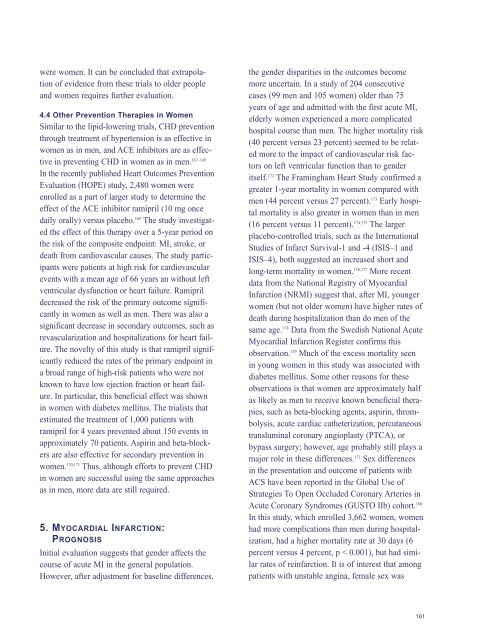WOMEN 'S HEALTH AND MENOPAUSE : - National Heart, Lung ...
WOMEN 'S HEALTH AND MENOPAUSE : - National Heart, Lung ...
WOMEN 'S HEALTH AND MENOPAUSE : - National Heart, Lung ...
Create successful ePaper yourself
Turn your PDF publications into a flip-book with our unique Google optimized e-Paper software.
were women. It can be concluded that extrapolation<br />
of evidence from these trials to older people<br />
and women requires further evaluation.<br />
4.4 Other Prevention Therapies in Women<br />
Similar to the lipid-lowering trials, CHD prevention<br />
through treatment of hypertension is as effective in<br />
women as in men, and ACE inhibitors are as effective<br />
in preventing CHD in women as in men. 167–169<br />
In the recently published <strong>Heart</strong> Outcomes Prevention<br />
Evaluation (HOPE) study, 2,480 women were<br />
enrolled as a part of larger study to determine the<br />
effect of the ACE inhibitor ramipril (10 mg once<br />
daily orally) versus placebo. 169 The study investigated<br />
the effect of this therapy over a 5-year period on<br />
the risk of the composite endpoint: MI, stroke, or<br />
death from cardiovascular causes. The study participants<br />
were patients at high risk for cardiovascular<br />
events with a mean age of 66 years an without left<br />
ventricular dysfunction or heart failure. Ramipril<br />
decreased the risk of the primary outcome significantly<br />
in women as well as men. There was also a<br />
significant decrease in secondary outcomes, such as<br />
revascularization and hospitalizations for heart failure.<br />
The novelty of this study is that ramipril significantly<br />
reduced the rates of the primary endpoint in<br />
a broad range of high-risk patients who were not<br />
known to have low ejection fraction or heart failure.<br />
In particular, this beneficial effect was shown<br />
in women with diabetes mellitus. The trialists that<br />
estimated the treatment of 1,000 patients with<br />
ramipril for 4 years prevented about 150 events in<br />
approximately 70 patients. Aspirin and beta-blockers<br />
are also effective for secondary prevention in<br />
women. 170,171 Thus, although efforts to prevent CHD<br />
in women are successful using the same approaches<br />
as in men, more data are still required.<br />
5. MYOCARDIAL INFARCTION:<br />
PROGNOSIS<br />
Initial evaluation suggests that gender affects the<br />
course of acute MI in the general population.<br />
However, after adjustment for baseline differences,<br />
the gender disparities in the outcomes become<br />
more uncertain. In a study of 204 consecutive<br />
cases (99 men and 105 women) older than 75<br />
years of age and admitted with the first acute MI,<br />
elderly women experienced a more complicated<br />
hospital course than men. The higher mortality risk<br />
(40 percent versus 23 percent) seemed to be related<br />
more to the impact of cardiovascular risk factors<br />
on left ventricular function than to gender<br />
itself. 172 The Framingham <strong>Heart</strong> Study confirmed a<br />
greater 1-year mortality in women compared with<br />
men (44 percent versus 27 percent). 173 Early hospital<br />
mortality is also greater in women than in men<br />
(16 percent versus 11 percent). 174,175 The larger<br />
placebo-controlled trials, such as the International<br />
Studies of Infarct Survival-1 and -4 (ISIS–1 and<br />
ISIS–4), both suggested an increased short and<br />
long-term mortality in women. 176,177 More recent<br />
data from the <strong>National</strong> Registry of Myocardial<br />
Infarction (NRMI) suggest that, after MI, younger<br />
women (but not older women) have higher rates of<br />
death during hospitalization than do men of the<br />
same age. 178 Data from the Swedish <strong>National</strong> Acute<br />
Myocardial Infarction Register confirms this<br />
observation. 179 Much of the excess mortality seen<br />
in young women in this study was associated with<br />
diabetes mellitus. Some other reasons for these<br />
observations is that women are approximately half<br />
as likely as men to receive known beneficial therapies,<br />
such as beta-blocking agents, aspirin, thrombolysis,<br />
acute cardiac catheterization, percutaneous<br />
transluminal coronary angioplasty (PTCA), or<br />
bypass surgery; however, age probably still plays a<br />
major role in these differences. 171 Sex differences<br />
in the presentation and outcome of patients with<br />
ACS have been reported in the Global Use of<br />
Strategies To Open Occluded Coronary Arteries in<br />
Acute Coronary Syndromes (GUSTO IIb) cohort. 180<br />
In this study, which enrolled 3,662 women, women<br />
had more complications than men during hospitalization,<br />
had a higher mortality rate at 30 days (6<br />
percent versus 4 percent, p < 0.001), but had similar<br />
rates of reinfarction. It is of interest that among<br />
patients with unstable angina, female sex was<br />
161
















